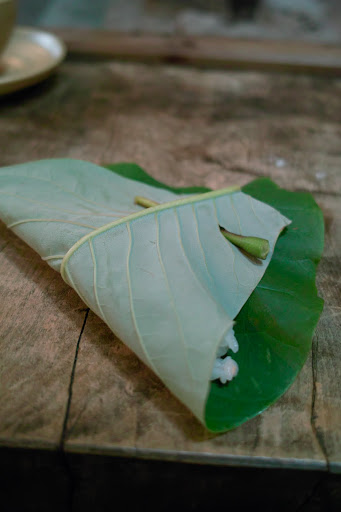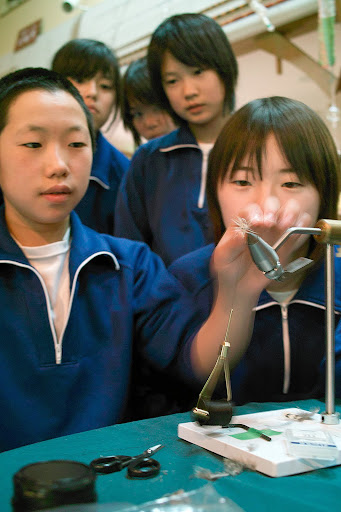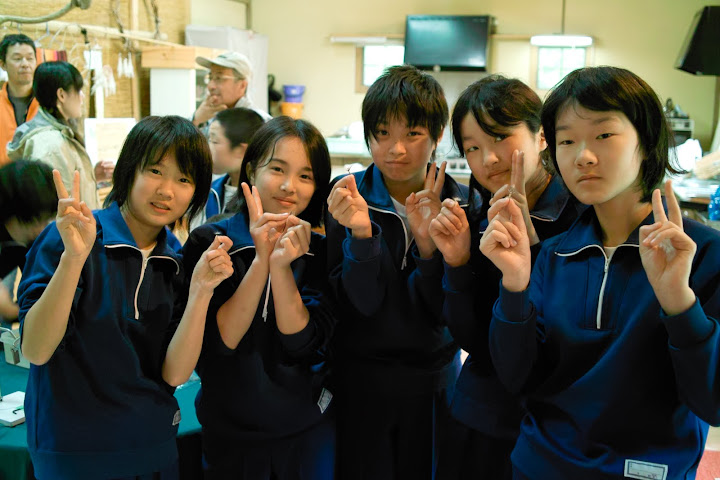Archive for the ‘Japan’ Category
A day with tenkara craftsmen
Yesterday I headed south to visit two craftsmen. The primary purpose of this trip was to visit the renowned tenkara net maker (tenkara tamo) Mr. Yukihiro Yoshimura, of the store “Mankyu”.
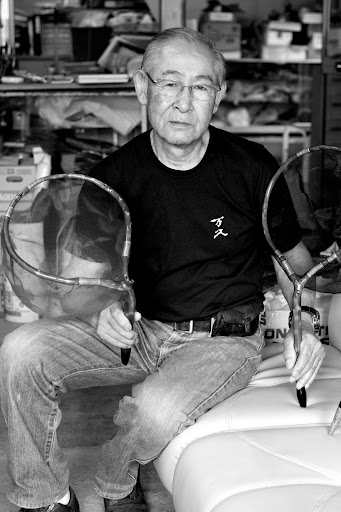
Visiting Mankyu was quite a dream. He’s the most renowned tenkara net maker in Japan and spending time looking at so many of his nets showed me he is a true master. Yoshimura-san has been making nets for 45 years, a craft he learned from his father. He’s also the longest practitioner of tenkara I know of , he’s been fishing tenkara for about 63 years.
Kuwata-san and I spent the morning with Yoshimura-san and his daughter, who helps him with the shop and works on connecting mesh bags to net frames. His daughter showed me how she connects the mesh bag to the nets by connecting a new bag to a frame I had made – they complimented my craftsmanship on the net construction, and gave me some invaluable pointers on finishing it. It was very impressive to see her skills at connecting the mesh to the frame, one of my most feared tasks. She said that often people make the frame and bring it to her for connecting the mesh.

We talked at length about tenkara nets. At one point in the conversation we discovered that both of us knew Katsutoshi Amano. Yoshimura-san picked up his cell phone and called Amano-san. Amano-san must have put in a good word for me, as Yoshimura-san then invited me to return and learn net making with him. I was definitely able to find time for that on my calendar, after all that’s one of the main reasons I wanted to come to Japan for an extended visit. I will be spending a full day with him the day before I return to the US.
Though I wish I had met him earlier to spend time learning about tenkara net making, this leaves me with an excellent reason to return next year, when I hope my Japanese will be much better. I will certainly write more about him after my day at his workshop. This encounter was quite a treat since Yoshimura-san frequently declines giving interviews to newspapers and magazines and has declined invitations by NHK to appear on tv.

I spent the night at the home of Kazuhiro Kuwata, who makes our tenkara leather wallets. It was great watching his craftsmanship as he finished a custom knife I had ordered for my own net making.
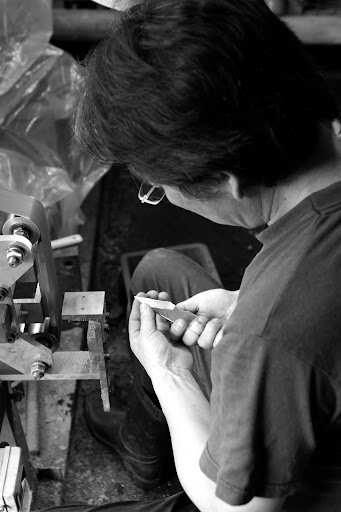
Kuwata-san lives and works in a large 100-year old traditional Japanese home in the country side. He loves vintage things and was attracted to the character of the house – which some people say is haunted.

We drank sake from his collection of Edo-period porcelain cups and enjoyed yakitori cooked on a irori . Kuwata-san doesn’t speak much English, so our conversations took place mostly in Japanese through the evening. Then he pulled out one of the vintage guitars he restored and played some American rock. These are experiences I wanted to have in Japan, and I’m happy I did.
Tenkara Class report
Back from a 2-day trip to Kaida-Kogen in Nagano prefecture. The event was incredibly fun, and I got to meet wonderful people.
In this picture Dr. Ishigaki teaching the class on day 2. Among other things he talked about the order one should try fishing a spot, start from the end of the pool and working your way up. He also demonstrated how working a spot from different directions can allow you to use different techniques (e.g. natural drift from below, pausing the fly from the side, dragging the fly from above, etc.)
Fishing was pretty difficult. I scored a few on Saturday, but got skunked yesterday. I had many drifts where I really expected a fish but nothing bit. I finally had a very nice rise at the end of the day, after Dr. Ishigaki and I had fished 3 other streams in the last couple of hours, and were at the end of our final 200 meter stretch with no bites of any kind. I got my fly to hang in one small spot long enough to get the interest of a fish, but I didn’t hook it.
The best thing about fishing frequently with someone who is a lot more experienced than you, is the confidence it gives you. Dr. Ishigaki likes to move quickly, so we’ll fish a stretch of a stream pretty fast and if nothing is happening we get on the car and check out a different section or different stream, as water temps or other factors may be different. But, there are days when it’s just not you, nor your technique, nor your flies, it’s just that the fish are not up to eating and there is not much that can be done about it.As has often been said, if it were much easier we wouldn’t call it “fishing”, we’d call it “catching”.
Preparing to fish a stream in the evening, the first of 3 Dr. Ishigaki would try in a couple of hours:
Moss-covered walls like these seem to be a constant presence on many streams. Walls have been built to prevent erosion of stream banks, since the water can get pretty high during heavy rains.
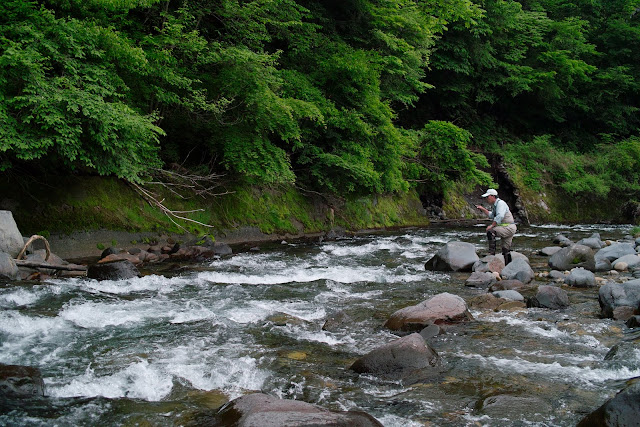
Our last stretch:
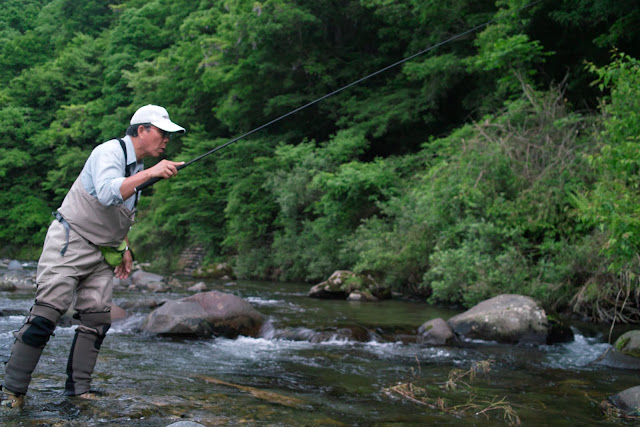
The inn we stayed in was pretty cool, a definite angler’s hangout. It’s called Mt. Ontake and run by Kazumitsu Suzuki and his wife. Here’s the URL for reference: http://www.mtontake.jp/. They served an awesome dinner and breakfast and at a very reasonable price.
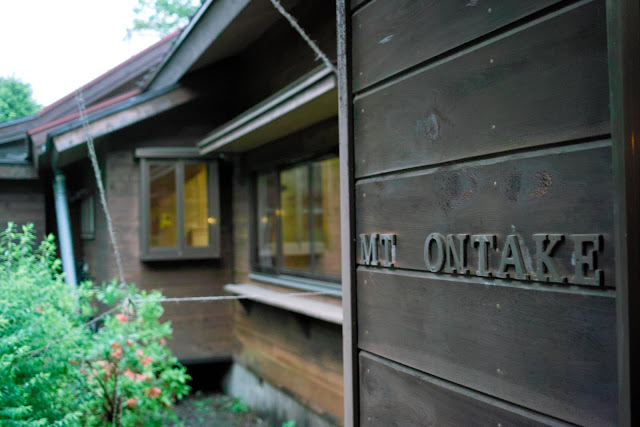
The spot is a regular destination for employees of the Patagonia store, which is how they got connected with Dr. Ishigaki. Last year he gave them a class on tenkara, and we’ll be there again this coming weekend to show them tenkara. It’s incredibly interesting how tenkara, Tenkara USA and the Patagonia company keep getting connected.
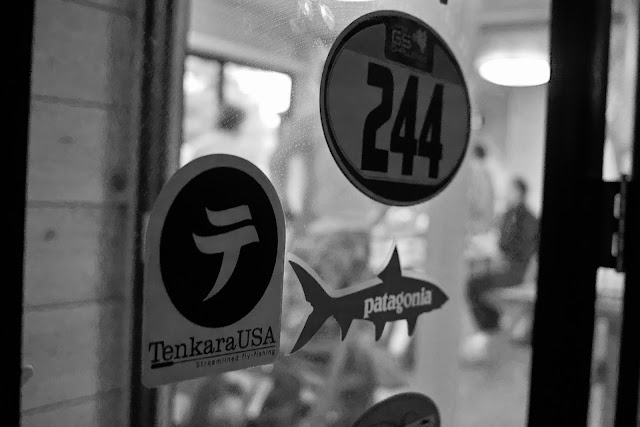
Suzuki-san and I got along great. He doesn’t speak English, but we were able to converse quite well about cameras, tenkara fishing, skiing and climbing Mt. Ontake, a trip we hope to do together next year. He even told me of a “secret” spot in Mt. Ontake area where he recently found several large Iwana but no one fishing as it’s a bit difficult to access. I may even be able to visit it before I leave.
Yesterday as the class took place, Suzuki-san took me around to fish in a couple of spots in the area. Suzuki-san is also a patrol for the streams in his area is responsible for checking anglers’ licenses. As he drove me around we stopped a couple of anglers. One didn’t have a license, but he readily pulled money to pay for it. Licenses typically cost about 1,000yen for a day ($12), and there is a penalty of 800yen if you’re caught without a license. Most people buy the license ahead of time, but it is a bit inconvenient to find the location to purchase one, so I don’t blame them for taking the chances without one.
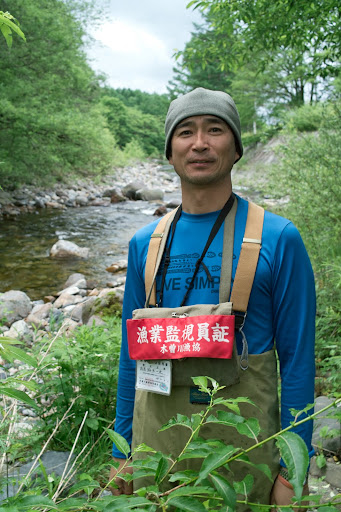
Tenkara in Japan – live
I thought I would not log on at all during the weekend, but found a few minutes of online time before heading to bed.
This morning I drove to Kaida-kogen, an area very popular among fishermen, for a tenkara class and fundraiser event with Dr. Ishigaki and Kurakami-san.
I left Maze at 6AM, arrived here at 8AM. It rained a little in the morning, and then hard in the afternoon. There were moments when the scenery was just awesome, at other moments the visibility was very low. Here’s a shot from one of the clear moments of the day when a layer of fog raises above the stream.
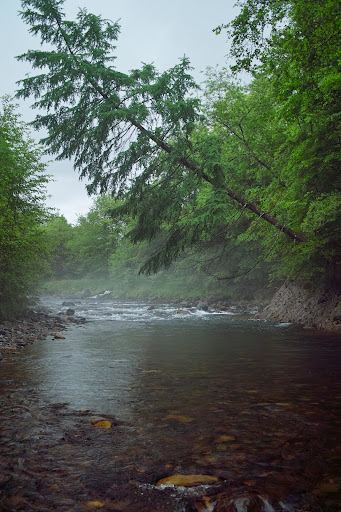
A little bragging, this morning I believe I was the only person to catch a fish in our group of about 15 people. And, in the afternoon I caught 4 fish, while the entire group had 1 fish among them. The stream has quite a few fish, but I believe the water was very cold today, and the fishing difficult. Not great numbers to really brag about, but it was easy to keep count today.

Here’s Ishigaki-sensei doing a demonstration to the class. He’s finally ditched the vest!!! Yes, he said it’s too hot and he doesn’t carry that many things in it anyways. I noticed he wasn’t using a vest on the Itoshiro event, so I finally asked him if he ditched it altogether.
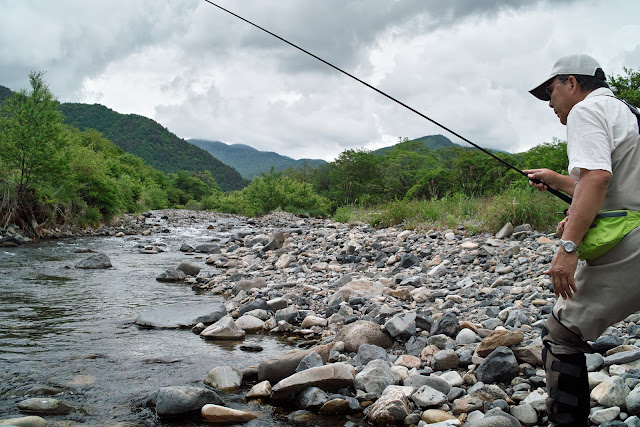
After fishing in heavy rain for about 4 hours, and catching my fair share for the day, I headed to an onsen. Just can’t seem to get enough of onsen, especially when it rains. I absolutely love that part of Japan for those rainy/cold days of fishing.
The most fun today may have been the charity event after dinner. Dr. Ishigaki and Kurakami san are taking every opportunity to raise some money for the earthquake victims. But, the event mostly consisted of underpricing things and if more than one person wanted the item they had to do rock/paper/scissors. It was a great way to have fun, but not a great way to raise money. I donated a Tenkara USA tshirt and a couple of sets of flies, those may have been the most popular items tonight. Then, the last item was the giveaway of a brand new Shimano tenkara rod. All those present participated in a rock/paper/scissors game to win the free rod. And, guess who won… yes, I did! But, I truly have no use for it as you may imagine, so I decided to turn it around and introduce an American-style auction into the party with bids starting at $50. The auction raised about $80, still a great bargain for the winner (photo below), but an additional chunk of money for the earthquake victims.

Pictures of tenkara fishing in Japan… and some Japanese terms for you
Tomorrow morning I’m headed for a 2-day tenkara event, and next week my schedule is packed. I hope to write more soon, but thought I’d leave you with a post of fishing before I go. This time I want to also share a few Japanese terms for specific types of stream, or terms that I use very often to figure out where to go fishing. Like the often cited example of eskimos have 30 words for different types of snow, the Japanese culture also developed a good vocabulary for describing their streams. To complete the post, I’ll include a couple of my best fish shots so far.
Japan has streams of many different kinds. The general term for river is “kawa“, but there are other more specific terms to describe different streams. Kawa can be “honryu“, which is the main stream, or “shiryu“, which are tributaries. Of course, a shiryu can also have other shiryus… Two other terms I use very often are “karyu“, which means downstream, or “jiuryu“, which means upstream.
Some are small, boulder strewn mossy streams. These are normally called “sawa“, the term for small streams, such as the one Yoshikazu Fujioka-san is fishing below, and my host Ikumi is fishing below that. I’ve been teaching Ikumi tenkara fishing and am very proud of how good her form is. We’ve only been out 3 times and her casting precision and technique impress me. She caught a fish on this evening (yumazume = evening activity period), Rocky and I didn’t.
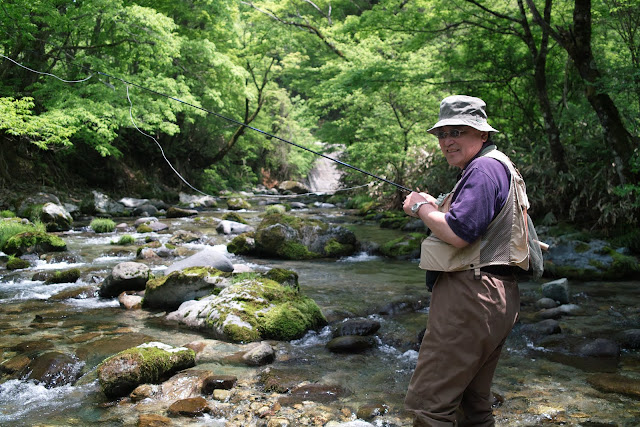

Mountain streams in general are called “keiryu”.
The keiryu below is being worked by Chris Stewart, the “Tenkara Bum”, who is referred by our Japanese friends as “tenkara baka”, though we’re still unsure that’s the best term for a bum. This was the “shiryu” to the Itoshiro, which is the “honryu” in the area we fished and one of the few catch and release streams in the country.

Keiryu also come in different styles. The clearest ones are called “seiryu”, which indicates they are “clear/beautiful/moving water types of streams. They may be large or small, but have the characteristic features of a mountain stream, boulders/pockets/currents. The Mazegawa is referred to as a seiryu. The Mazegawa has at least 100 distinct parts, that feel like entirely different streams. The one picture below shows my hosts, Ikumi on the foreground and Rocky farther downstream. The pool in front of her is about 12ft deep and we could easily see every rock below.
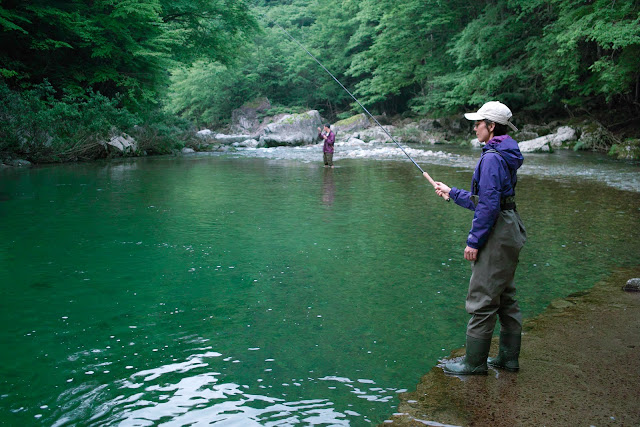
Some are large, slower rivers, these are just normally referred to with the general name “kawa/gawa” – there may be a more specific term, but I still haven’t learned it. The picture below was taken in Gujo soon after the ayu fishing season started. I’ll write more on ayu fishing later, but for now, suffice it to say it’s not tenkara! It’s done using a live “decoy fish”. It’s definitely a serious activity here. I may even call it “the bass fishing of mountain streams”.
Other streams are very steep, and the walls around it form a type of canyon. These are generally called “tani/dani”. These are the streams where people may do “shower climbing”, or sawanobori – interestingly, the activity is called “sawanobori”, because tani may or may not have water in it (it’s a canyon area), and shower climbing requires water, thus “sawanobori” is used. I helped take a group of kids on an outing to one of these streams, but no fishing allowed there. Next friday I’m scheduled to go explore a “tani” and will do some tenkara fishing. Actually, I’m supposed to catch lunch. Here’s the place I wish I had fished, but instead I enjoyed some awesome canyoning:
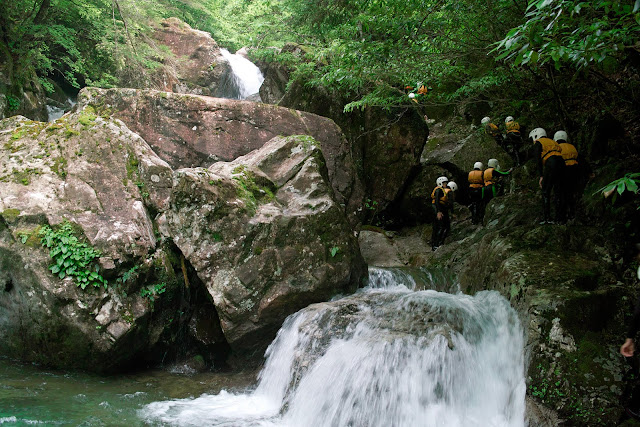
The fish here are just gorgeous, when I can see them I get excited about fishing again. In this area we can catch Iwana, and Amago. On the Japan sea side, one may find the yamame. Next week I have an outing scheduled with a local whose favorite stream is a couple of hours away and we can catch yamame.
This is a picture of a Iwana, my best fish on this trip. It’s not the largest fish one can catch here; last week on the ryokan I visited, the owner had a beautiful mounted display of a 20.5inches (52cm) Iwana. The Fishing Center has a dried 25inch Iwana on their wall. Tenkara was also used to catch some large fish.

Here is an amago I caught on a “shiryu”, the term for tributary. Notice the small red spots, the differentiating mark between the amago and the yamame. I hope to have a picture of yamame next week.

Visiting the tamo shops
Early this week I looked at my calendar and Wednesday was a free day – I have been busier on this trip than I had ever imagined. So, I decided to revisit the tamo shops a couple of hours away from here. This was my third visit. I actually had to return before I leave to pick up a couple of pre-ordered mesh bags for my nets. But, mostly I was excited to look at all the nets I could before the end of my trip.
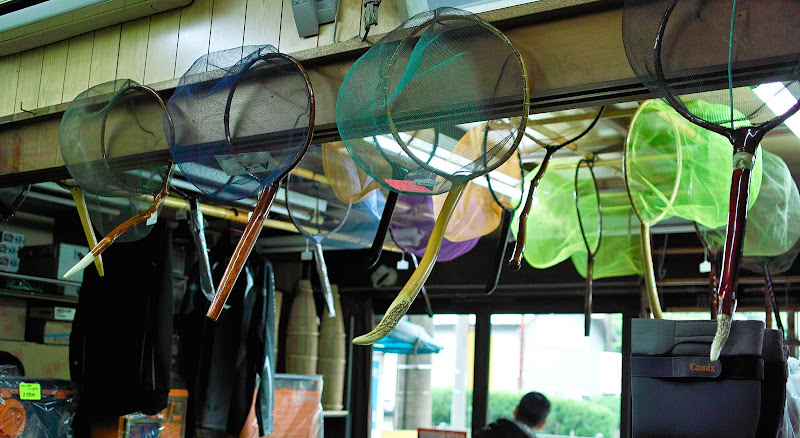
On the drive over, I noticed the same mountains I had seen when driving with Chris a couple of weeks ago. This time I found a better viewing spot and was able to setup my tripod for a more stable shot and some video.
Last year Dr. Ishigaki took me to visit one of the stores, where I fell in love with tenkara nets. Then, a few weeks ago Eiji Yamakawa and his friends came to this area, but as it was raining very heavily on our second day they decided to visit the tackle shops instead of going fishing, I tackled along. This time I wanted to go on my own. I wanted to take my time in observing the style of different net makers and I wanted to talk to the owners of the stores with no rush, no time to go back, and without feeling like I’m taking someone else’s time. Furthermore, this would be excellent Japanese practice.
My Japanese is still very crude, but I’m finding that on the topic of fishing I have been holding decent conversations, being able to ask the questions I want (even if sounding like a Tarzan), and understanding most of the responses. Sometimes I still count on my iPhone, which in Japan has become an expensive dictionary, though I’m relying on that less and less. Also, I do keep a small moleskin notebook and pen with me at all times and take note of new words and refer to ones I learned before. I have had numerous hour+ long conversations here, and those have been some of the most fun (though challenging) experiences in Japan. There is something about living on the country-side, where people seem open to taking their time in conversing with a stranger, arriving at common grounds and sharing common experiences. Whereas most encounters in big cities seem dictated by a one-hour time block, here I have sat for a cup of coffee and talked with people with no pre-allocated amount of time. Sometimes conversations are quick, other times 3 hours long, nonetheless each is a big opportunity to learn about 10,000 new things.
(by the way, though tenkara is mostly for smaller fish, if you still think it is only for the very small fish, take a look at the mounted fish on Shimizu’s wall, fish of that size or larger are a common decoration on walls of businesses in this area)
The first tamo shop I stopped at is owned by Shimizu-san. By far my favorite store and where I got my first net last year. A few weeks ago when we tried to stop by they were closed, so I was happy to find his store opened on this visit. Shimizu-san’s store has been around for about 40 years and was previously owned by his father. At this time of year, ayu fishing season is starting and the river across the street from his store was filled with ayu anglers (more on this later). A couple of times fishermen came in dressed in their neoprene waders to talk to Shimizu, as I admired each of the nets he had on display. This year’s collection of nets from different makers was nothing short of extraordinary. The nets were much more expensive than they had been last year, but each of the nets was of very high quality. Also, his store only stocked kaya-tree nets this year, as opposed to nets made from other trees like the “momi”. He says kaya nets are the best and he’s not carrying nets from other woods this year. He and I had a good conversation. I didn’t meet him last year, but he said his wife had mentioned meeting me last year.
Then, I revisited another store where I had stopped a few weeks earlier. I actually had to return to the area before I left since I had pre-ordered 2 custom mesh bags from the maker. I had asked if they had any mesh bags to sell, but they didn’t, preferring instead to use the bags for their own nets. However, he agreed to prepare a couple for me and have them ready within about 10 days. So, I stopped there and picked them up for my upcoming kaya nets. Here’s a picture of the maker about 30 years ago, this picture hung on the wall:
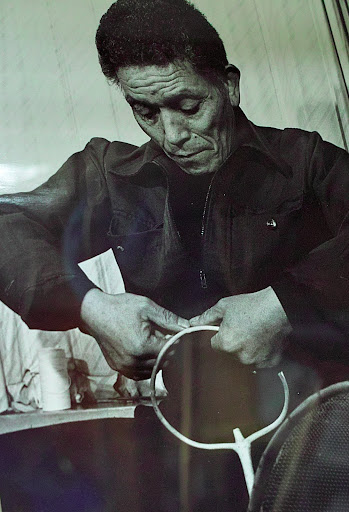
Remembering earthquake and tsunami victims 10,000 candles
This weekend the Mazegawa Fishing Center hosted the Hoba Sushi Festival. The highlight of the event was the lighting of 10,000 candles, made from recycled cooking oil, to remember those who lost their lives on the earthquake and tsunami disaster of March 11th. The candles lasted as long as 3 hours as those present enjoyed live performances by a group of artists. Everytime I looked around I was filled with awe from the energy around us. The moon popped behind the mountains on the other side of the river, candles lined up the small stream feeding the Mazegawa. It’s hard to put into words the energy I felt at the event, but thought I’d share a few pictures.
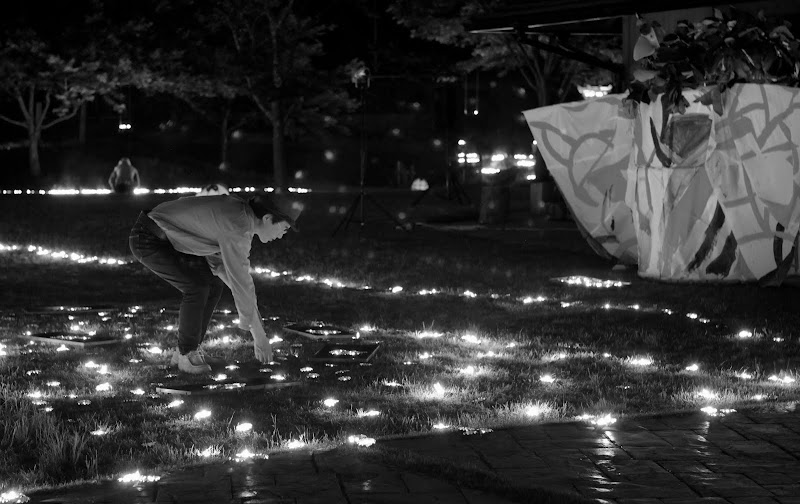


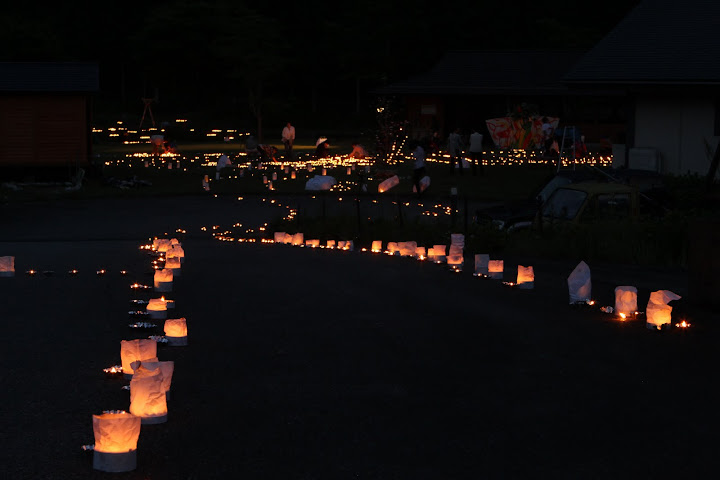




Today's view from my room
Actually, the title is a bit delayed. This was the view from my room yesterday, when I stayed at a most quaint ryokan (type of hotel) in the small town of Osaka 小坂 (not to be confused with the big city of Ōsaka, 大阪). In case anyone is interested in coming to this area (highly recommended if you can), the ryokan is the Sengakukan, very famous in the region (and for disclosure, I did receive free room and board without any expectations of promoting it, though I’m happy to do so).
Osaka is famous for its waterfalls and “shower climbing” (canyoning through waterfalls and pools). In all, the area is estimated to have over 216 waterfalls, though some people suspect it has even more falls that are hidden deep in the woods.
How I cam here was interesting. On Saturday, I met the owner of the ryokan here in Maze. She said her husband really likes fishing, and that I should get to know their town and possibly fish with him. She invited me to come the next day and stay there. What an awesome couple of days those were.
The ryokan was right next to a gorgeous river, which you can see on the picture above. The owners of the ryokan took me around town to see the waterfalls (they hiked around in their yukata robes, adding to the feel of “romantic Japan” that many people may have).
After hiking to the falls I met two local guides of my age, who volunteer as guides during the weekend. They said they do shower climbing and enjoy fishing. We agreed to fish the yumazume (the evening activity period) together. We were also treated to a 5-star dinner by the owners of the ryokan and were joined by their son who works there and is about my age. Unfortunately, we couldn’t find dates to go shower climbing/tenkara fishing together before I leave. I have to return next year so we can do the 3-day canyoning trek to Mt. Ontake.

The fishing was okay. As with most streams in Japan, the number of fish in the rivers was not that large. The fish that do remain in the water are just gorgeous, as they have not been beaten up by bad catch and release practices.
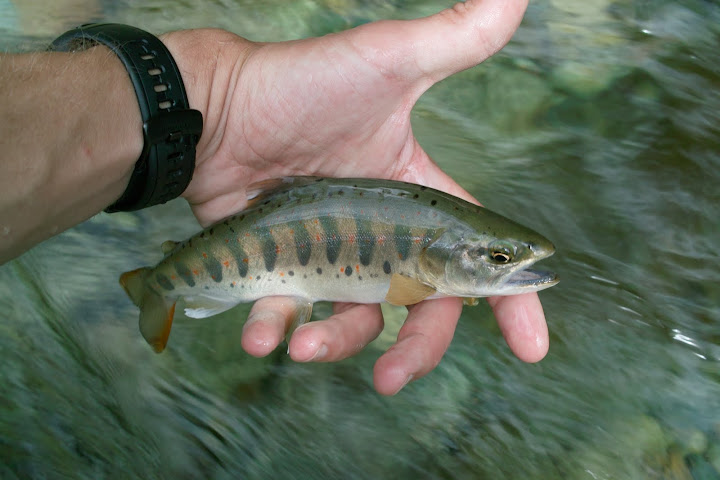
The stream behind the ryokan featured a few points where natural spring water bubbled up. The onsen water feeds a fountain inside the hotel where one may drink it – it has a very interesting soda texture to it, but tastes a bit like, well, fart (yes, the sulphuric smell of many onsen water sources). Apparently it’s very good for your health, but I could only must a glass of it. A few dishes are also cooked with that water. Hot onsen water also feeds the outdoor bath of the ryokan. Today I learned that the word onsen is used for both hot and cold spring water, though it’s normally associated with hot water in Japan.
I will have to write another post very shortly about the Hoba Sushi Festival over the weekend. It was a surreal event during the evening, as we lit 10,000 candles on the fishing center grounds and lining the banks of the stream next to it to remember the victims of the earthquake and tsunami.
Japan as a mountain painting
There are paintings that portray the mountains of Japan forming beautiful layers of colors. I have been seeing these pretty often when I drive to different fishing destinations. This was a shot taken when Chris and I were driving to Itoshiro. It was awesome to see 6 clear layers of mountains overlapping each other.
Yesterday's stream that I didn't fish
Following a weekend of typhoon weather, with very heavy rains that raised water levels by about 3ft, yesterday I didn’t fish. But, I couldn’t sit still. I wanted to see what kind of photography I could capture with water levels still a bit high in most places (though not nearly as high as it was on Monday). The light was pretty interesting. I spent a few hours hiking along sections of the Maze river and found this spot. The climb down to the river was very difficult, and perhaps a bit dangerous, but the setting idyllic. The moss remained on the rocks despite a roaring river the day before. It was meditative, not a person nearby. I plan to fish this stretch when water levels return to normal.
Photo updates from Japan
I know, I know – I promised to write a bunch while on my “sabbatical” in Japan, and I haven’t been delivering. I have been fishing though. I have fished with a bunch of great people and some of the masters of the art of tenkara. I have been enjoying some of the most beautiful streams I have seen and seeking others. I have also found some wood for my new tenkara nets. So much going on, so little time. It’s already been almost 20 days since I arrived in Japan. And, yes, I have been learning more about tenkara. I will share more. Meanwhile, here are some pictures from the last couple of days:
A gorgeous stream, a “shiryu”, or “tributary” of the Mazegawa:
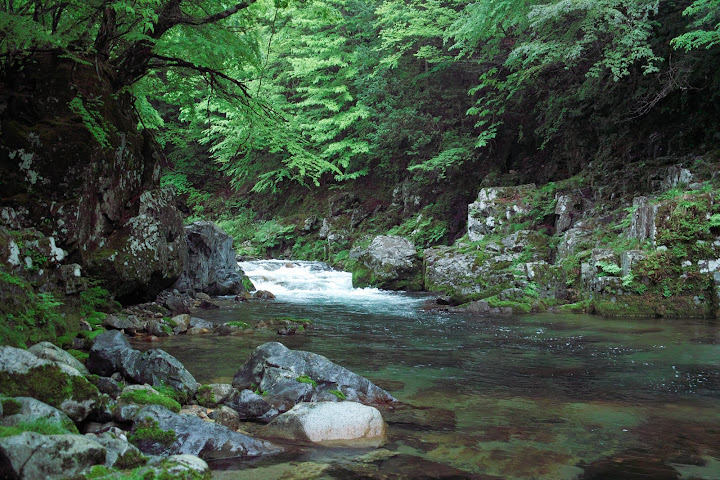
While many people take a lot of fish, I’m happy to know fish can find sanctuaries of gorgeous water, but no fishing allowed, this is what the sign looks like:
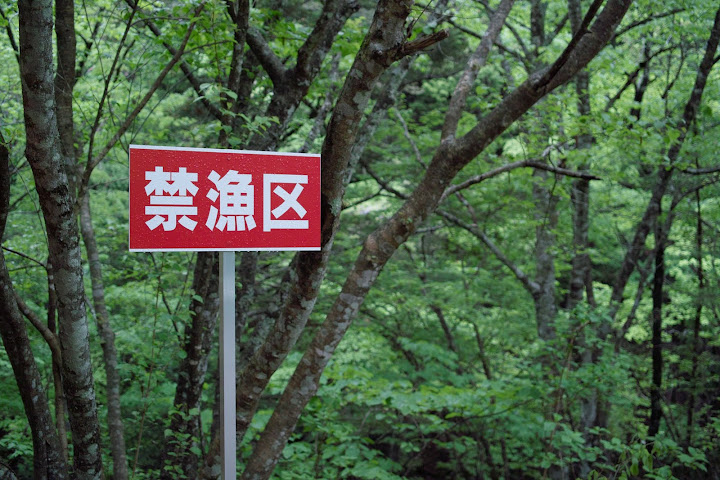
Fishing with Eiji Yamakawa, and two of his friends from their tenkara fishing club, awesome guys:

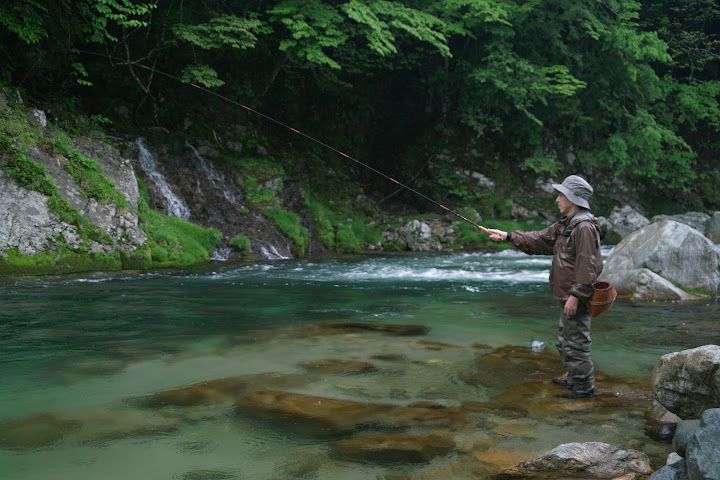
After much looking, finally found the rare “kaya” tree [update: they were not kaya, but rather the more commonly found “momi” trees, I finally found an ancient kaya forest and learned about their differences]. I found the trees 2 days after reading that as much as 45% of the forests of Japan have been replaced with cedar (“sugi”) tree plantations. Indeed, cedar is about all you can find here, but deep in the woods there are other trees. I climbed a kaya momi, and found others where the branches were accessible. What an impressive tree:

Fuji no Hana 藤花Originally posted on June 10, 2010

There will be some new content for those of you who have been reading our blog for over a year. I do not want to keep duplicating entries, but, this one is a timely one for our area of Japan.
Last year I talked about how the Fuji flower (藤花, fuji flower, wisteria japonica), is considered to be the “tenkara flower”. This is because when the fuji flower’s blossom is an indication that fishing is good. I have been in Japan for over 15 days now. Sadly, the fishing in this area has been very poor, and, tellingly, until yesterday I had not noticed the Fuji flowers in the area I’m staying. Today, they seem to have bloomed and are starting to appear in many places. While I still suspect the fishing here won’t improve all that much (I’ll talk some other time about the poor management of fisheries in Japan), the almost overnight flower’s blossom is a sign for hope.
Originally posted on June 10, 2010, after fishing in Japan at this exact time of year last year.
This time of year is considered the best time for tenkara fishing in the mountain streams of Japan. One of the main indicators of this is the Fuji hana (藤花, fuji flower, wisteria japonica). The fuji flower is commonly found near streams in Japan at this time of year, and when it’s blooming it’s said to be tenkara fishing time. So, I’ll call the fuji flower, the tenkara flower. Now we need to find one for tenkara in the US.
The character for the fuji flower (藤) is the same character as Fujioka-san (藤岡), so they joke that’s his flower. This is the fish he caught just about an hour earlier:
Fujioka-san with a nice Iwana
One morning I was able to get very close to the fuji flowers, they tend to be found a bit high, but a few hours before I was able to I had dunked my camera’s lens, a big SLR lens, into the water as I landed a fish. It’s what I call my karma neutralizer. I didn’t realize it until later, but the picture I took was a bit foggy. Luckily I was able to get back there before the trip was over and take a better picture.

Tenkara Japan A quick preview
Sakasa Kebari tied by Amano-sensei, free-hand, with no tools and eye-less hooks. Sakasa Kebari hold quite a esteem here.
It’s been 12 days since I arrived in Japan seeking to learn more about tenkara and experience the mountain fishing culture of Japan. This is my third visit to Japan, and each time I continue to learn more and more about tenkara. Who knew such a simple method of catching food would have so many subtleties to keep me coming back!
Tenkara and Tenkara USA for me are much more than selling fishing rods and other items; I’m very passionate about sharing the method of fishing with you. I’m happy to be writing this and working on videos, pictures and other content from my new room overlooking the mountains of Gifu. I will try to find time between fishing and hanging out with the people from the area to share what I learn on the blog. Rainy days like today are perfect for that.
After about a week of travelling, I have now been settled in what will be my home for the next month and half in the small mountain stream village of Maze, on the Maze River in Gifu, Japan. It’s a beautiful, idyllic setting. Very inspiring. Out of 12 days in Japan I think I have fished on 8 of them. I can’t say enough about how beautiful the streams here are, I absolutely love them. Crystal clear water, emerald gems with movie-like settings of cedar forests and mossy rocks.
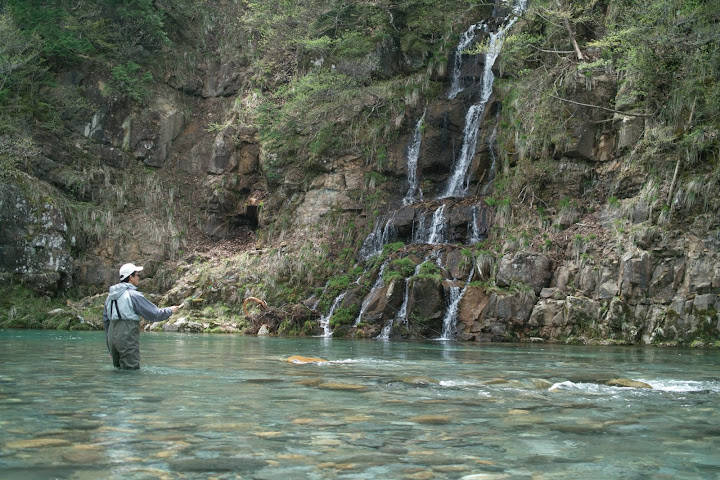
Chikara fishing an idyllic stream, great fishing, poor catching 😦
But,unfortunately, I’m quickly acquiring a new appreciation for the streams in the US and sometimes I wish I could mix the best of both worlds, where regulations, and stream management and keep-limits would make the rivers here more productive. Rivers don’t have a keep-limit and the concept of catch-and-release is virtually unknown – though I revisited the Itoshiro River, a very productive C&R river about 1 1/2 hours from here. Out of the many stretches of streams I have fished in this area, few showed much sign of life. I did catch fish just about every day, but it was hard work! Conditions are good, insect life very abundant, but the fish seem to be mostly gone. A shame, but we’ll see what I find deeper in the forests.
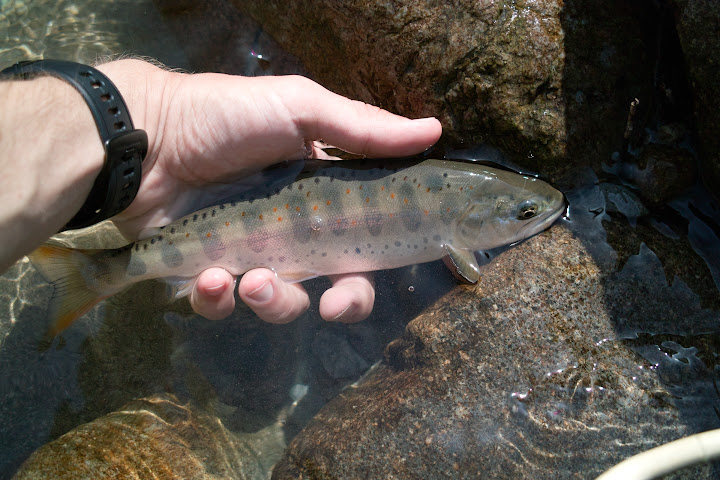
A beautiful example of an Amago, a native, though seemingly rare fish.
My host, Rocky Osaki, manager of the Mazegawa Fishing Center, and his wife Ikumi, have taken great care to introduce me to the community of both anglers and non-anglers in the region. I have been blessed to be invited into numerous homes where I soak all I can about tenkara, fishing culture and other aspects of life here. And, of course, have been soaking on the local onsen every chance I get.
A local kid whom I just had to nickname “Sanpei”, he doesn’t seem to mind.
This weekend there was a wonderful event here. 3 tenkara masters, and I do not use that word lightly, taught a course on tenkara to a group of about 15 people. I spent most of my time with Amano-sensei (more on him later, but quite a character and a most skilled tenkara angler).From each of them, as well as other very experienced tenkara anglers, I have learned more about tenkara.
Tenkara fishing course
Ah, and today I was featured in the regional newspaper, in an article talking about the event and the presence of Tenkara USA there:
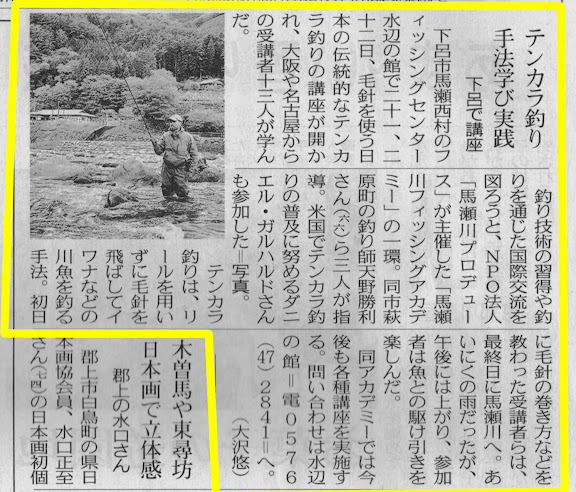
Checking in from Japan A view of where I'm staying
Not much writing on this blog post today.
But, in case anyone is curious, here’s a panorama I did yesterday with my iPhone of the Mazegawa Fishing Center. This is the place I’m spending almost my entire time. It’s one of the coolest places on earth to spend 2 months. A fishing center, with access to canyoneering gear, a tenkara-perfect river right in front of it and a hot-spring onsen just up the hill. I’ll try writing more later. Now, back to studying Japanese before I head out to fish some more.
Hope most of you can see this 360′ view of the place. You may need special software for it and I apologize for that.
Here’s the location of where I’m staying, notice the abundance of mountains and streams in the area!!! The town I’m staying doesn’t have a convenience store, nor traffic lights. It’s very quite, and gorgeous. Mountain view galore, and streams in abundance:
Live interview for Japanese radio 東京ラジオ局J-Wave ・テンカラのインタビュー
I have suspected that the popularization of tenkara in the US would help create even more interest for tenkara fly-fishing in Japan. Today, Tenkara USA founder and CEO (yes, me, Daniel Galhardo) gave a live interview about tenkara for the Tokyo radio station J-Wave, in their program, “Global Frontline”. They were very interested in tenkara, particularly because most people in Japan still have no idea what tenkara is, but it’s being widely adopted here in the US.
The introduction is in Japanese, but the interview was fully done in English. It’s now available on iTunes as a free podcast. You can also listen to it on your iPhone, just search for “Global Frontline”. CLICK ON IMAGE BELOW FOR PODCAST LINK:
Tenkara USA interview for Tokyo radio station, J-Wave “Global Frontline”: http://itunes.apple.com/us/podcast/j-wave-jk-radio-tokyo-united/id322103767#
Tenkara bamboo rod
There is something to be said about using a natural material as a tool. Particularly if this is simply crafted. Particularly if the focus is not on manufacturing it, but on selecting the best, most natural and suitable material there is, and simply touching it up to make it a long-lasting tool. Such is the tenkara bamboo rod, as well as the original tenkara net (more on this later). Non-split, non-manufactured, very rare, just incredible.
Dr. Ichihashi, tenkara bamboo rod maker
I had briefly seen a tenkara bamboo rod when Ishigaki sensei visited the Catskills last year, and I had read about it, but had not, until now, had a chance to feel a real tenkara bamboo rod. Then, I got to feel each of a group of some 12 rods, “feel them and pick the one that fits you best”, said Dr. Ichihashi, 市橋 寛, a local pediatric doctor who has been crafting tenkara bamboo rods forseveral years. What? Pick one? How could I? These are just incredible. But, how can I possibly say no and mean it? I had to feel the rods, I found my match, or as the cliche goes, it found me. All I could say was “domo arigatou gozaimasu”, while bowing very deeply for such generous gift, and hoping a gift of a hat and shirt could express a little gratitude.
Gorgeous handles, made of natural bamboo, or wrapped.
These are not the usual cane-pole rod. Yes, they are cane, but their action, weight, balance, are all those of a fly rod. The tenkara bamboo rods are made with 3 or 4 pieces of bamboo. Each rod uses 3 different species of bamboo, selected to be used as the rod butt, the middle of the rod, or for the tip. Plus the handle, which is often made from bamboo rhizome (roots). The selection and matching process is long. Dr. Ichi Hashi goes on his “expeditions” to the hills of Gifu prefecture, not far from Gujo, and selects the best bamboo for his rod. He does this during the late fall/early winter, when the humidity level in the bamboo is at its lowest. Then, he’ll dry the bamboo for up to 2 years in the attic of his clinic. At that point he’ll match the bamboo pieces to be used for the different segments of the rod. He’ll then clean the inside of the rod, opening the nodes to allow the thinner pieces to slip in; he’ll wrap the ends of the segments to strengthen then and lacquer them. And, finally, apply his mastery to finishing each rod. It’s pretty incredible that his rods look like they are all made from one single bamboo, the nodes often look identical, and the taper is flawless.
Incredibly, the nodes of these rod were perfectly aligned. A hard feat.
A 4-piece rod. Pieces are alternated to fit inside a thicker one.
Dr. Ichi Hashi also enjoys fishing with his bamboo rods the most, and I can see why. They are generally slower rods, but like our tenkara rods they come in a variety of flavors, there are the very thin/light rods that are soft (5:5) and there are those that feel stiffer/faster (6:4 or 7:3) , there are some rods that are slightly heavier, but can also be slow (5:5) or faster (6:4 or 7:3). Regardless of their action or weight, one striking feature of bamboo tenkara rods is their recovery. This is also different from the good’ol’cane pole. Since a tenkara bamboo rod is made for casting a line, the bamboo selected and used for them has great recovery. When you shake them (e.g. cast) the rod will flex as much as it’s made to flex, but it will recover and stop shaking promptly, thus it does not dampen the cast.
Dr. Ichi Hashi has extended me a serious invitation to come spend time with him learning how to make tenkara bamboo rods. There are not many people who make these nowadays. After feeling these rods, I believe there is a lot to be learned from them that can and should be applied to modern rods. Plus, how could I say no to that, when at 14 years old I was trying to learn how to select bamboo to make a cane-pole? Dr. Ichi Hashi, please expect me in Gujo again in the near future. And, domo arigatou gozaimasu.
To learn more about bamboo rods (is this a tenkara rod? and the point of divergence), click below.
Read the rest of this entry »
Where in Japan were we?
So, you may be asking, where exactly in Japan did you go?
We spent most of our time in the Itoshiro River, which is located in the Gifu province, and what we may call the “tenkara capital” of Japan. We also visited the Mazegawa, which was a beautiful river, but a bit high when we came. Gifu has a enormous variety and number of streams that are “tenkara-perfect”. See the interactive map below for exact locations where our pictures were taken.
http://maps.google.com/maps/ms?ie=UTF8&hl=en&msa=0&msid=115281063052794282472.000488ca37d7f1d589c57&ll=36.044658,136.801758&spn=0.388635,0.878906&z=10&output=embed
Japan presents a few challenges for travelling, mainly the language and signage, which in some places is completely in Japanese characters. However, that is a minor detail in light of the best public transportation system in the world, and the fact that most people are very willing to help. Of course, in this trip I had the help of a good friend from Japan and Dr. Ishigaki was driving us around. To get to that area we took a Shinkansen from Tokyo to Nagoya, from there a subway ride to meet Dr. Ishigaki near his University, and a 3 hour car ride to the Itoshiro.
Fuji no Hana, 藤花
This time of year is considered the best time for tenkara fishing in the mountain streams of Japan. One of the main indicators of this is the Fuji hana (藤花, fuji flower, wisteria japonica). The fuji flower is commonly found near streams in Japan at this time of year, and when it’s blooming it’s said to be tenkara fishing time. So, I’ll call the fuji flower, the tenkara flower. Now we need to find one for tenkara in the US.
The character for the fuji flower (藤) is the same character as Fujioka-san (藤岡), so they joke that’s his flower. This is the fish he caught just about an hour earlier:
Fujioka-san with a nice Iwana
One morning I was able to get very close to the fuji flowers, they tend to be found a bit high, but a few hours before I was able to I had dunked my camera’s lens, a big SLR lens, into the water as I landed a fish. It’s what I call my karma neutralizer. I didn’t realize it until later, but the picture I took was a bit foggy. Luckily I was able to get back there before the trip was over and take a better picture.

Living a dream – Learning tenkara from the master
I just landed back in San Francisco a few hours ago. I find myself a bit dizzy from all the travelling and the jet-lag. And, to be honest, my entire experience in these last 2 weeks has just been so beyond my expectations that it is a bit overwhelming trying to digest it all. But, I figure I have to start somewhere. I plan to slowly publish my experiences, techniques I learned, new insights, interviews, videos, and anything I can share with you.

Daniel with an Amago
Maybe it was growing up watching Karate Kid and other martial arts movies where the pupil goes off to live in a remote mountain village in Asia to train with a well-known master, but for many days I felt like I was living a dream that had been engrained in my mind from my early years, the stuff of a movie. Now that I think of it, it is natural it would be fishing, not martial arts, that I’d be pursuing knowledge of. A couple of days ago my mind brought back the memory of fishing with my dad, watching someone catching a lot of fish, and my dad telling me that if I wanted to learn how to fish I should ask a Japanese person how he does it – the region I grew up in has a very large Japanese immigrant population, and there has always been a stereotype held by my dad, possibly a fact, that the Japanese were incredible anglers. Many years later I am blessed to have the opportunity to go to Japan specifically to learn tenkara directly from the master, Ishigaki-sensei, as well as many other very gifted anglers such as Yoshikazu Fujioka and Sakakibara Masami (aka Tenkarano-oni). I may be the first westerner to have ever received such in-depth focused training in the art and techniques of tenkara. For most of the last 2 weeks I was taken under the wings of the most renowned authority on tenkara in Japan, Dr. Hisao Ishigaki (hereby referred to as Ishigaki-sensei, as he has become my de facto teacher). I learned more about pure tenkara than I could ever have imagined I would.

Ishigaki sensei focusing on the water
Iwana
Daniel, Ishigaki-sensei, Fujioka-sensei, Chikara
Sakakibara Masami (aka Tenkara no Oni)
I spent many days fishing with Ishigaki-sensei: observing, learning, being observed and unequivocally taught. I also met some of the most well-known people in the world of tenkara at in Japan and was extremelly welcomed by the anglers and communites of the Itoshiro and Mase (Masegawa) rivers: being interviewed a couple of times and appearing at a local newspaper. I was also received as a guest of honor at the “Itoshiro Fisher’s Holiday”, an annual gathering cellebrating the beautiful Itoshiro river, one of the first “Catch-and-Release” rivers in Japan, and even gave a brief speech at one of the biggest tenkara events in the country.
Saitou Shouichi, one of the event's founders and organizer
Angler's barbecue - very well organized
During the event I sought feedback from many people present, and Tenkara USA’s rods, lines and flies were carefully reviewed by some of the most demanding tenkara anglers in the world, dully critiqued (which will only make our rods even better in the future), but an attestment to our products, they received a big nod of approval by people who take tenkara very seriously! Receiving this type of feedback is extremelly valuable, and I’m grateful to have made those connections.
A few of the things I plan to write about in coming days are:
– Interview with Ishigaki-sensei: We spent many hours driving around and having very in-depth conversations about tenkara in the car. These conversations allowed me to ask some questions that bring out a lot of insight and philosophy from the master, as well as the modern history of tenkara in Japan and other things. He also discusses his scientific experiments on fish and anglers.
– Tenkara nets: Japanese design has yet to disappoint me, specially when it comes to its “practical simple elegance”. I have not been so enamoured with something since my “discovery” of tenkara rods. Being in the center of tenkara in Japan, I was able to learn quite a bit about tenkara nets, and their extremelly simple nature, and very organic design has left me in awe, which I hope to share with you.
– Tenkara flies: The simplicity of tenkara is summed by the fact that all you need is a rod, line and A fly. More commonly than I had thought almost all tenkara anglers use one pattern only (whatever their chosen one is). It is very common practice among all tenkara anglers to rely purely on their techniques to find and entice fish, not on changing flies. At this point I have become a firm believe in this approach on faster flowing streams. While anglers will debate which fly works best – some may prefer a fly tied using the skin of a poisonous snake (more on this later), others may use the natural dubbing from the flowering fern (zenmai), and others may just use cheap thread and a simple hackle – it’s widely accepted that one fly is all you need.
– Fishing techniques: The techniques used in tenkara are generally simple, but they are the main pillar of tenkara fly-fishing. Technique, not gear, should be the focus of any activity, although modern society has tended to put a premium on the latter. Relying on gear, even on changing fly patterns, not only detracts from the experience, but also from one’s growth as an angler. I plan to share the techniques I learned in Japan, they work on any faster flowing stream. And, anyone can do well with them and one fly.

– Tenkara bamboo rods: You used to think split-cane rods are nice, well, I’ll tell you, tenkara bamboo rods crafted by a good craftsmen, are just masterpieces. I have next to me what are probably 2 of less than a handful of tenkara rods outside of Japan, and they are just sweet, simple crafts. Made by Dr. Ichi Hashi, a Pediatrician in nearby Gujo, they are wonderful works. Why split something that works so well as given by nature?
– Landing fish technique: While very intuitive, the big lessons here were slow it down! Bring the fish to a shallower part of the water. Let it calm down by holding the line (trust the tippet) and net it. No more lost fish at the last second.

Iwana
– Travelling and fishing in Japan: Japan is likely the best country in the world for small stream fishing. Many people I talk to say their first love is small stream fishing, but if they ever travel is to pursue big fish in tropical countries. Japan is a wonderful country to experience, and the small stream fishing there is top-notch. I’ll try sharing some advice.





